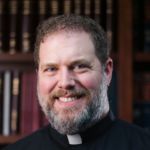
Let’s talk about trees. That could be a sub-heading for three of our readings today
Ezekiel speaks about God’s provision for the house of David, symbolized by a tree. The context of this passage is the impending destruction of Jerusalem and the exile of the chosen people. From a secular political viewpoint, this prediction likely came across as idealistic fantasy: how could a people ever recover from such a catastrophe, much less rebuild and thrive, becoming “majestic,” towering over all the other trees of the forest? This dramatic transformation is suggested also by our Lord in Mark, where the tiny mustard seed becomes the largest of plants, providing shade and shelter for many.
It’s likely that Jesus has just this passage from Ezekiel in mind when he makes his comments. It is also likely that both he and the prophet have in mind the many other scriptural tree images, especially those of the Psalter. Hence the fitting lines from our psalm: “The righteous shall flourish like a palm tree; and shall spread abroad like a cedar on Lebanon: such as are planted in the house of the Lord, shall flourish in the courts of the house of our God” (Ps. 92).
The first psalm in the Psalter presents a similar comparison:
BLESSED is the man that hath not walked in the counsel of the ungodly, nor stood in the way of sinners, and hath not sat in the seat of the scornful. But his delight is in the law of the LORD; and in his law will he exercise himself day and night. And he shall be like a tree planted by the water-side, that will bring forth his fruit in due season. His leaf also shall not wither; and look, whatsoever he doeth, it shall prosper.
This image of a godly person planted by the stream of the word of God has always struck me as an appropriate opening to the entire sequence of Israel’s song book. In a way, the psalms are just this taking of delight in the law of the Lord, meditating on it, soaking it up, and allowing it to bear fruit.
No wonder, too, that the portion of Psalm 92 quoted above, Iustus ut palma, is a common text in the Church’s tradition of sacred music and liturgical poetry. This past Wednesday, I was celebrating a votive mass of St. Joseph, and there I was, struck by that same psalm as the Introit. Whether it’s Joseph or one of the martyrs, the Christian imagination has long appreciated the image of the saint as a tree planted and well established, drinking and growing not only for its own health, but for the sake of all around it. The saints nourish us with their fruit, shade us with their branches, protect us with their sturdy trunks.
I needn’t remind you that the Garden of Eden also featured trees. We discussed last week the nature of obedience and the significance of the forbidden fruit as a disordering of love. But today’s focus on trees and organic growth suggests yet another hidden meaning to that foundational story. For surely it is no coincidence that Adam and Eve are placed in a garden. Paradise is a garden full of trees and other plants. In other words, humanity is surrounded with creatures that grow slowly and deliberately, that flourish best when cultivated and assisted, but that cannot be forced or built or constructed from the outside.
Many of the Fathers and theologians have wondered what the human story would have looked like if our first parents had not fallen from grace. This is, mind you, not a firm teaching of the Church, but I find that the most convincing theory is that humanity was always, even before the Fall, destined for the supernatural vision of God. But even without the Fall, this supernatural vocation would have required a kind of development—in other words, it would take time for time-bound and material creatures, even creatures that were already in their own nature perfect, to acquire the habits necessary to unite themselves fully with the eternal. A true fellowship between God and man would require not some kind of external technology, but an interior growth.
Though the actual course of history took another turn—perhaps, in some mysterious way, a better one, as the sacred liturgy itself implies (“O happy fault”)—the necessity of growth remains. God is not some arbitrary despot toying with us through the chances of history. Rather, the fact of history, the fact that time goes on when even we in our limited imagination can conceive of it not going on, of God ending it all right now in fire, judgment, and the completion of all things, tells us that there is really no substitute for the work of time. The fact that inspired Scripture gives us so many tree images is a pretty clear warning. You cannot hurry a tree.
Just a few weeks ago at Pentecost, we recalled how the Holy Spirit’s coming to the Church reverses the division and separation symbolized by the tower of Babel in Genesis. But think back to the tower itself, or at least what the tower represents. In that story, the peoples of the earth unite behind a new technology, the brick, to conquer the heavens. On many levels, it seems a silly story. Who, really, could imagine building a tower to heaven? And in fact, shouldn’t we want to reach heaven? Yes, we should. But the story reveals the danger of treating heaven as a technological achievement. A tree does not reach into the heights simply because we build a pillar under its roots. The tree just has to grow, as do we.
The analogy works well, following the various scriptural metaphors, for individual persons. Yet it is also a fitting description of the Church. As the pastor of a parish in a missionary diocese, it is a constant challenge to remember that growth must always happen naturally.
Now, we can think about baptisms as, in a way, grafting on new branches to the organism. That, too, is a scriptural metaphor. So the point isn’t that all technology is bad—surely it is a good thing to understand how best to nourish a tree. The point is that you cannot just paint the leaves a different color, or attach more branches with a rubber band. Ultimately, the life of the parish has to be rooted and connected with its source, and it’s much better to have a healthy small tree than a dying tree with a bunch of pretty false bits taped on.
There are some limits to this metaphor. The Church, as we say in the Creed, is one. I’m not sure that that means we have to imagine her as a single tree, or as a single orchard, or a single large garden cultivated by the Lord. She is all of those things, and none of them, and more. There have been some bad and misleading arboreal metaphors over the years, chief among them a “branch theory” that many of us heard as Anglicans, asserting that basically the Catholics, the Orthodox, the Anglicans, and possibly other Protestants are all just “branches” of the one Church. That image is historically naïve and incoherent, repugnant to the teaching of the early Church, but it lives on because it contains some nuggets of truth, such as the validity of baptism and the true proclamation of certain parts of apostolic doctrine.
There are, if you will, threads by which these so-called “branches” hang on to the main body. But Jesus doesn’t call us to be loosely connected with the body, to receive nourishment in an accidental and haphazard way. He wants us to receive all of his grace. All of him for all of us. He doesn’t just want us barely to stay alive. He wants us to thrive, to grow, and to bear fruit, just as he intended from the very beginning. We can do that only when rooted in his word, nourished by his sacraments, and fixed in the place where he has called us.



